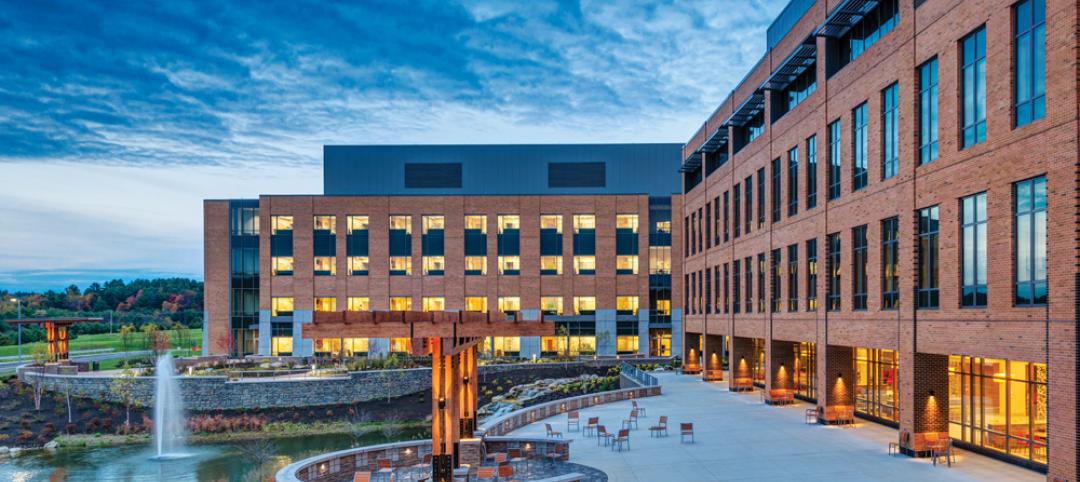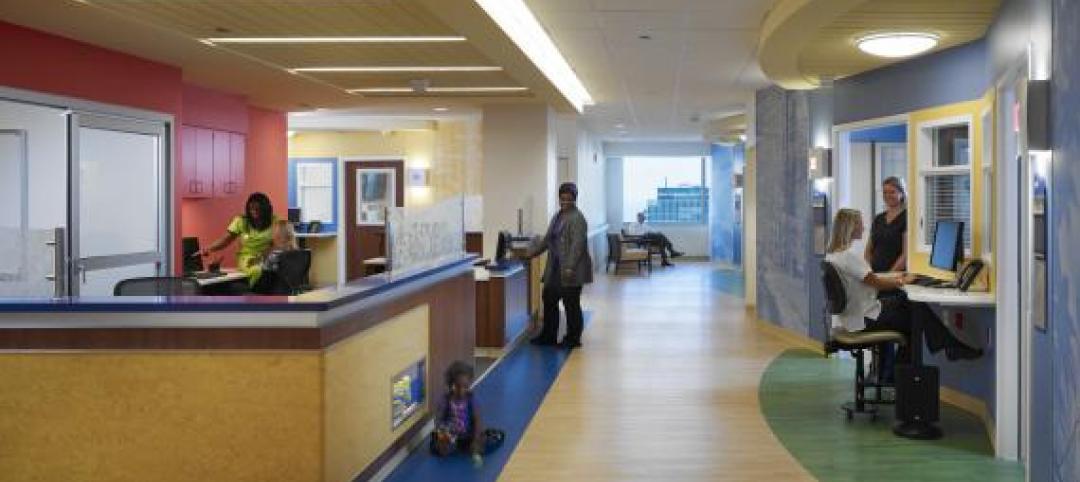Faced with the complexities of value-based payment models and the uncertainties surrounding healthcare reform, the nation's healthcare delivery systems are taking the long view of their operations.
“They're looking at everything from organizational structures, staffing, and services, all the way down to the cost of building and operating a facility,” says Mike Zorich, PE, LEED AP, Client Executive with engineering firm IMEG.
Case in point: Boston Medical Center's multi-year campus consolidation will trim its footprint by 60 beds and 329,000 sf, saving $25 million a year in operating costs.
See also: Top 160 Healthcare Architecture + AE Firms - 2018 Giants 300
See also: Top 90 Healthcare Engineering + EA Firms - 2018 Giants 300
See also: Top 105 Healthcare Construction + CM Firms - 2018 Giants 300
Academic medical centers are also modernizing. The IPD team for Sutter Health’s California Pacific Medical Center, San Francisco—which includes SmithGroupJJR, Boulder Associates, and HerreroBOLDT—is building two replacement hospitals, closing an existing campus, and converting another one from inpatient to outpatient care.
“We are quickly transitioning from patient-centered to patient-driven care,” says Heather Chung, EDAC, LEED AP, VP/Health Studio Leader, SmithGroupJJR. “Patients are changing what it means to be accessible and convenient and are shaping what healthcare providers deliver.”
“The healthcare market continues to reach further into communities and away from the traditional hospital for many front-line services,” says IMEG’s Zorich. “Healthcare buildings used to be designed for more than 50-year life spans, but many of the smaller off-campus outpatient facilities are now looking at 20 years or less.”
An emphasis on reducing costs and improving efficiency is fueling the use of Lean construction and prefabrication.
Prefab helped Skanska shave more than $200,000 in construction costs off a 444,000-sf hospital expansion at the University of Virginia Health System, Charlottesville. “Laser scanning identified opportunities for the prefabrication of materials alongside critical in-place infrastructure that could not be interrupted,” says Andrew Quirk, Senior Vice President and National Director of Skanska USA’s Healthcare Center of Excellence.
AEC firms are also stepping up the use of VR and AR tools. “Not only can VR and AR help our clients understand department layouts, adjacencies, workflows, and finishes during the design process, but clients can continue to use these tools to maintain and operate their facilities more efficiently,” says Mike Stapf, Vice President, Design Integration, McCarthy Building Companies.
doubling down ON RESILIENCE, collaboration
Resilience is guiding the design of healthcare facilities, particularly in regions vulnerable to extreme emergency events. “Healthcare facilities need to maintain services during and after extreme events, and this drives priorities in a very different direction than before,” says Pat Bosch, LEED AP, Design Director, Perkins+Will, Miami.
In South Texas, P+W is leading the expansion of Christus Spohn Hospital Corpus Christi–Shoreline, a pilot project using the RELi rating system. RELi helps project teams plan for hazards and emergencies that could cut power and heat or compromise a building’s functionality.
The hospital's leaders recognized the facility's role as a regional command center in the event of a natural disaster or terrorist threat and as a place of refuge. "They identified resilient design as a top priority," says Julie Frazier, Associate Principal, Perkins+Will, Dallas.
Masonry skin, impact-resistant glazing, and galvanized exposed metals will protect the 10-story structure during extreme events. If HVAC systems are knocked out of service, reflective roof surfaces will minimize heat gain; sun-shading devices will filter natural sunlight on patient floors. Several days' provision of food and water will be stocked.
Another new healthcare design trend: translational medicine, which brings researchers and clinicians under the same roof to hasten discoveries that accelerate individualized patient treatments.
“Just as the AIDS epidemic needed a new way of thinking, cancer care and clinical care in general need a new way to take advantage of advanced technology and research methods to deliver innovative, personalized care and treatment for their patients,” says Hank Adams, AIA, ACHA, EDAC, Global Director of Health at HDR.
Transdisciplinary integration is breaking down the physical and organizational barriers that have traditionally separated these areas, to speed up the development of life-saving therapies.
“The merging of patient care, education, and science into one contiguous platform is the future of academic medicine,” says Scott Rawlings, AIA, FACHA, LEED AP, Director of Healthcare with HOK.
“Leading institutions are finding that focusing superspecialties into one building that combines clinical care, trials, research, and education enables them to quickly translate basic research findings into prevention and treatment and to enhance patient care,” says Rawlings.
Related Stories
| Mar 19, 2014
How to develop a healthcare capital project using a 'true north charter'
Because healthcare projects take years to implement, developing a true north charter is essential for keeping the entire team on track and moving in the right direction.
| Mar 18, 2014
6 keys to better healthcare design
Healthcare facility planning and design experts cite six factors that Building Teams need to keep in mind on their next healthcare project.
| Mar 18, 2014
How your AEC firm can win more healthcare projects
Cutthroat competition and the vagaries of the Affordable Healthcare Act are making capital planning a more daunting task than ever. Our experts provide inside advice on how AEC firms can secure more work from hospital systems.
| Mar 13, 2014
Do you really 'always turn right'?
The first visitor center we designed was the Ernest F. Coe Visitor Center for the Everglades National Park in 1993. I remember it well for a variety of reasons, not the least of which was the ongoing dialogue we had with our retail consultant. He insisted that the gift shop be located on the right as one exited the visitor center because people “always turn right.”
| Mar 12, 2014
14 new ideas for doors and door hardware
From a high-tech classroom lockdown system to an impact-resistant wide-stile door line, BD+C editors present a collection of door and door hardware innovations.
| Feb 21, 2014
Naturally ventilated hospital planned in Singapore
The Ng Teng Fong General Hospital will take advantage of the region's prevailing breezes to cool the spaces.
| Feb 18, 2014
Study: 90% of healthcare providers say Affordable Care Act is 'step forward,' but major revisions needed
Providers are excited about opportunities to address long-term health issues in the U.S., but worries about the transition persist, according to a new study by Mortenson Construction.
| Feb 17, 2014
Lawmakers may take away control of Florida hospital project from the VA
The project is $100 million over budget and has missed its scheduled completion date.
| Feb 14, 2014
Crowdsourced Placemaking: How people will help shape architecture
The rise of mobile devices and social media, coupled with the use of advanced survey tools and interactive mapping apps, has created a powerful conduit through which Building Teams can capture real-time data on the public. For the first time, the masses can have a real say in how the built environment around them is formed—that is, if Building Teams are willing to listen.
| Feb 13, 2014
3 keys to designing freestanding emergency departments
Having physically disassociated from a central hospital, FEDs must overcome the particular challenges associated with a satellite location, namely a lack of awareness, appeal, and credibility. Gresham, Smith & Partners' Kristin Herman-Druc offers three keys to success.
















